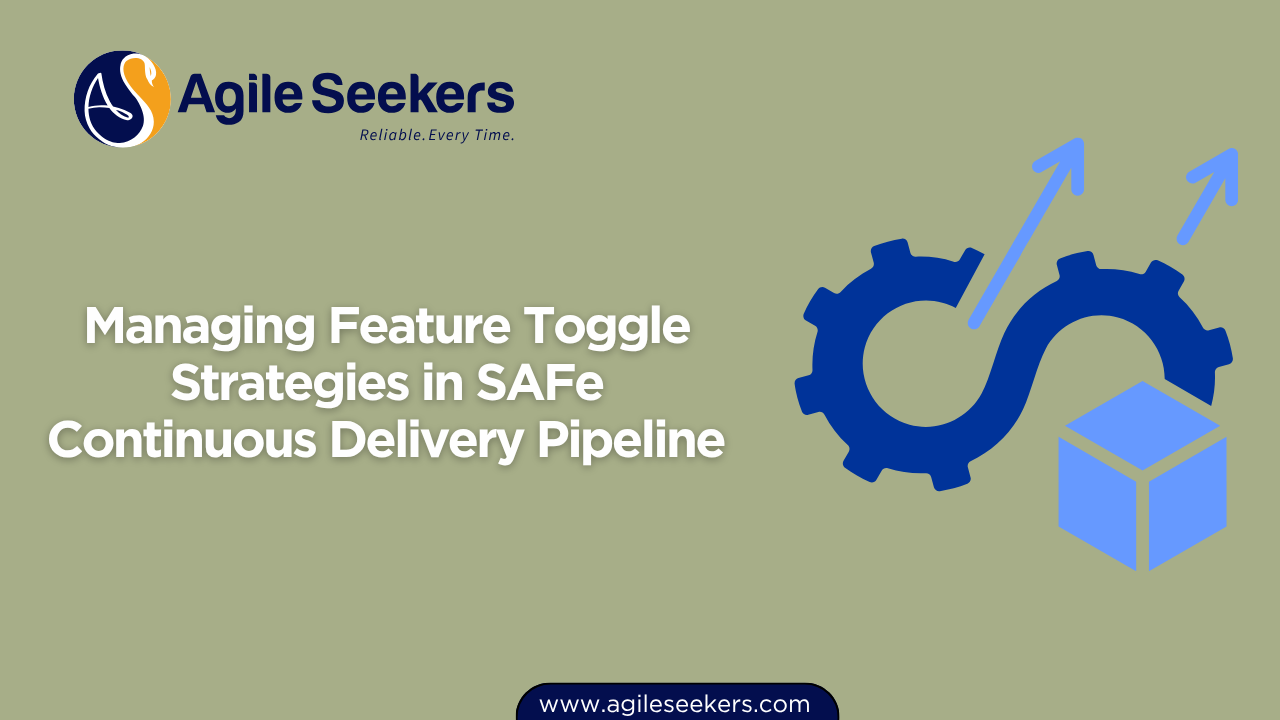Managing Feature Toggle Strategies in SAFe Continuous Delivery Pipeline

Feature toggles, also known as feature flags, are a cornerstone of modern software delivery, especially within the SAFe framework. In a Continuous Delivery Pipeline (CDP), they allow teams to decouple deployment from release, mitigate risk, and experiment safely in production. For organizations practicing SAFe, managing toggles strategically is crucial to maintaining flow without compromising quality or customer experience.
What Are Feature Toggles?
Feature toggles are conditional statements in code that enable or disable features at runtime without changing or redeploying the codebase. These flags can be turned on or off dynamically, providing flexibility for teams to test in production, perform A/B testing, or gradually roll out functionality.
Martin Fowler classifies toggles into four categories: release toggles, experiment toggles, ops toggles, and permission toggles. Understanding these helps SAFe teams align toggle use with delivery goals.
Role of Feature Toggles in SAFe's Continuous Delivery Pipeline
SAFe's CDP includes four key activities: Continuous Exploration, Continuous Integration, Continuous Deployment, and Release on Demand. Feature toggles touch each stage:
- Continuous Exploration: Product Owners and Managers explore value hypotheses and identify features that may benefit from toggles for testing and validation.
- Continuous Integration: Developers integrate toggled features into the mainline codebase without impacting stability.
- Continuous Deployment: Code is deployed frequently, with toggles ensuring that incomplete features remain hidden.
- Release on Demand: Business stakeholders and certified professionals can release features strategically based on market needs or readiness.
Types of Feature Toggles in SAFe
| Toggle Type | Purpose | Use Case in SAFe |
|---|---|---|
| Release Toggles | Enable trunk-based development while keeping features dormant until ready. | Hide incomplete features during System Demos. |
| Experiment Toggles | Test different user experiences in production. | Validate feature assumptions with MVPs. |
| Operational Toggles | Manage infrastructure behaviors. | Enable logging or throttle services during IP Iteration testing. |
| Permission Toggles | Grant access based on roles or user segments. | Control feature access by ARTs or business units. |
Why Product Owners and Managers Must Own Toggle Strategy
While developers implement toggles, Product Owners and Product Managers are responsible for defining the purpose, audience, and retirement criteria. Aligning toggle usage with the Program Backlog and PI Objectives ensures value delivery remains intentional and measurable.
This ownership is reinforced in SAFe POPM training, which emphasizes prioritization, hypothesis validation, and system thinking across ARTs.
Best Practices for Feature Toggle Management in SAFe
1. Define Clear Toggle Lifespans
Every toggle should have a planned removal date. Dead toggles add tech debt and increase cognitive load. Make removal part of the Definition of Done for the feature.
2. Use Toggle Management Tools
Platforms like LaunchDarkly, Split.io, or Flagsmith offer granular control, audit logs, and rollout rules. These help teams within ARTs manage toggles consistently across services.
3. Avoid Over-Toggling
Too many toggles can reduce clarity. Use them selectively for experiments, MVPs, or risky deployments—not as a crutch for indecision or incomplete work.
4. Version Your Toggles
Introduce toggle versioning when changes to behavior may affect multiple teams. This avoids downstream surprises in shared components.
5. Align with Enablers and Architecture
Coordinate with System Architects to ensure toggles don’t bypass security, performance, or logging enablers. This reinforces the Architectural Runway and supports compliance across ARTs.
Real-World Examples of Toggles in SAFe Programs
Example 1: MVP Rollout for New Checkout Flow
An e-commerce ART uses an experiment toggle to expose a redesigned checkout only to 5% of users. Metrics show reduced drop-off rates, validating the hypothesis. The toggle then enables a gradual rollout to 100%.
Example 2: Backend Service Migration
During Continuous Deployment, an ops toggle lets teams route traffic between legacy and new services without downtime. Observability dashboards monitor error rates before shifting full traffic.
Example 3: Feature Enablement by Segment
A permission toggle controls access to a dashboard feature only for enterprise users. The Product Manager coordinates with sales to enable it post-upgrade.
Common Pitfalls to Avoid
- Long-Lived Toggles: Features shipped months ago still controlled by toggles create confusion. Remove them once the rollout completes.
- No Visibility: Teams lack dashboards or visibility into active toggles, leading to accidental misuse. Build visibility into release planning tools.
- Uncontrolled Scope: Developers add toggles without consulting product leadership. Enforce approval workflows for toggle creation.
Feature Toggles and SAFe Governance
Product governance in SAFe extends beyond features. Toggle use must align with Lean Budget Guardrails, security policies, and audit trails. Treat toggles as configuration assets—subject to version control, test automation, and risk review.
This alignment is covered extensively in SAFe Product Owner Certification courses, where business agility and risk-based thinking are embedded in delivery practices.
Retiring Feature Toggles
Retirement is as important as implementation. Build toggle removal into PI Planning and iteration goals. Mark toggles as deprecated in your configuration management tool. Once confidence is high, remove the conditional code and perform regression testing.
When Not to Use a Toggle
Not every feature needs a toggle. Avoid them when:
- The feature is trivial and poses minimal risk.
- The feature is isolated and non-user-facing.
- The release is tightly coupled with a fixed date and can't be delayed.
Conclusion
Feature toggle strategies are critical to fast, reliable delivery in a SAFe environment. When managed well, they empower teams to test, release, and learn without fear of disrupting users. But without governance, they introduce risk and complexity.
To lead this balance, SAFe POPM certified professionals must take accountability for toggle design, purpose, and retirement, working in close collaboration with architects, developers, and business stakeholders.
By doing so, they enable a Release on Demand strategy that delivers value when it’s needed—confidently and predictably.
Also read - Enforcing Definition of Done (DoD) Across ARTs for Technical Consistency
Also see - Driving Portfolio-Level Backlog Refinement with Guardrails




















